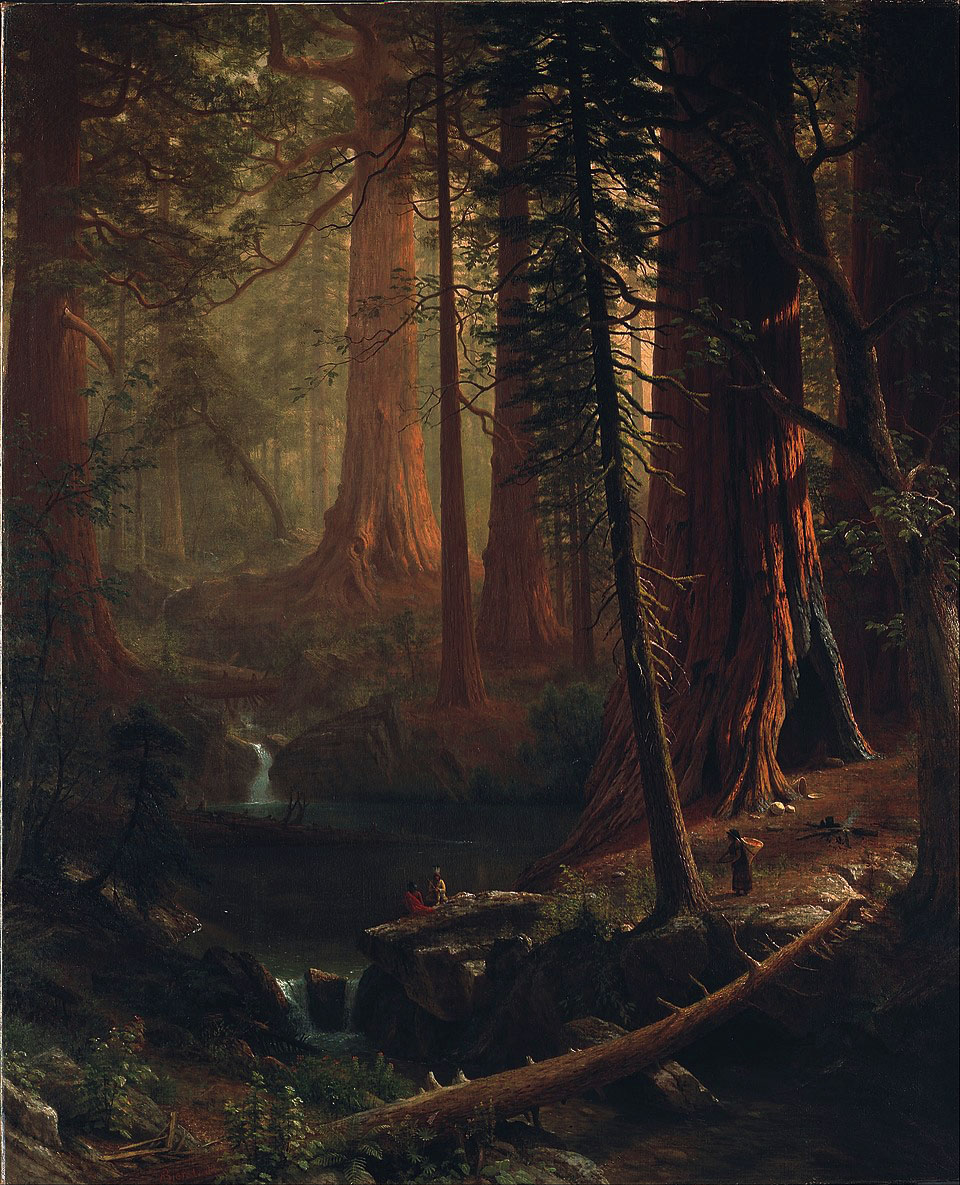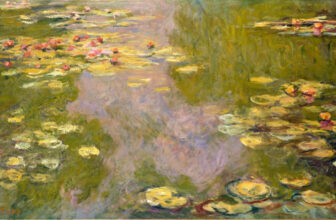
A Deep Dive into Albert Bierstadt’s Giant Redwood Trees of California Painting
Albert Bierstadt’s “Giant Redwood Trees of California” is a painting that evokes wonder, reverence, and introspection. Crafted by one of the most celebrated American landscape painters of the 19th century, this artwork is not just a visual representation of California’s towering sequoias, it is a philosophical, cultural, and symbolic expression of the American wilderness, manifest destiny, and humanity’s relationship with nature. In this comprehensive exploration, we will unpack the painting’s meaning, symbolism, artistic style, historical context, and current location, as well as offer a close interpretation of what is happening in the scene.
What Is “Giant Redwood Trees of California” All About?
“Giant Redwood Trees of California” is a majestic landscape painting by Albert Bierstadt, created in the mid-to-late 19th century during his extensive travels in the American West. The painting captures a grove of California’s iconic coast redwoods or sequoias, some of the tallest trees on earth, with sunlight filtering through their colossal trunks, casting dramatic shadows across the forest floor. Bierstadt’s portrayal of the redwoods is more than mere botanical interest, it is a grand romantic vision of untouched American wilderness, rich with spiritual and nationalistic overtones.
Bierstadt was not simply painting what he saw; he was painting what these sights meant to a generation of Americans seeking identity, expansion, and transcendence. The painting invites viewers into an almost sacred space, a cathedral of trees where the light of heaven seems to filter down to earth through columns of living wood.
The Rise of the American Landscape
To understand Bierstadt’s “Giant Redwood Trees of California,” one must situate it within the broader context of 19th-century America. During this era, the country was experiencing westward expansion under the doctrine of Manifest Destiny. The newly acquired western territories were seen not only as economic opportunities but also as divine providence, a fulfillment of a national mission.
Bierstadt, along with fellow artists of the Hudson River School and the Rocky Mountain School, became visual chroniclers of this expansion. His travels with surveying expeditions allowed him to access and document landscapes that many Americans would never see. Through his monumental canvases, he offered Eastern audiences a window into the awe-inspiring beauty and vastness of the American frontier.
What Is Happening in the Painting?
In “Giant Redwood Trees of California,” the immediate visual impression is one of quiet grandeur. Towering redwoods rise skyward, their trunks stretching vertically and almost disappearing into the canopy. These trees dominate the composition, dwarfing everything else, humans, animals, even light itself.
Often, in Bierstadt’s landscapes, small figures such as travelers, Native Americans, or wildlife are placed in the scene to convey scale and reinforce the overwhelming power of nature. In this painting, such figures may be present but are secondary to the trees themselves. The focus is squarely on the forest as a cathedral, a spiritual sanctuary unmarred by industrial development.
The interplay of light and shadow suggests a moment of divine illumination. Shafts of sunlight beam through the trees, highlighting foliage and creating a dreamlike quality. The misty atmosphere adds depth and mystery, inviting the viewer to ponder what lies beyond.
While there is no narrative in the conventional sense, no central action or protagonist, what is happening in the painting is transformation: the transformation of perception, the elevation of nature to a sublime ideal, and the fusion of art and spirituality.
Symbolism and Interpretation:
Nature as the Sublime
The primary symbolic reading of “Giant Redwood Trees of California” revolves around the concept of the sublime. In 19th-century Romanticism, the sublime referred to experiences that transcend ordinary perception, moments of awe and wonder, often found in nature, that reveal the limits of human understanding. Bierstadt’s painting is a visual representation of this aesthetic. The trees are not just large, they are mythic. Their verticality and scale evoke the same sense of wonder as Gothic cathedrals or mountaintop vistas.
Redwoods as National Icons
The redwoods themselves are symbols of endurance, ancient wisdom, and the American wilderness. By painting them with such reverence, Bierstadt was helping to elevate them to national icon status, living monuments of the American landscape. Their inclusion in art helped shape conservationist sentiment, contributing indirectly to the later establishment of national parks and forest preserves.
Light as Divine Presence
The use of light in Bierstadt’s painting is not just technical, it is symbolic. The heavenly shafts of light that stream through the redwoods can be interpreted as the presence of the divine in nature. This aligns with Transcendentalist thought, championed by figures like Ralph Waldo Emerson and Henry David Thoreau, which posited that nature was a direct conduit to spiritual truth.
Human Insignificance and Reverence
If figures are present in the scene, they are always subordinate to nature. This composition suggests a humbling of the human ego in the face of the natural world, a theme deeply resonant with Romantic ideals. The viewer is invited to reflect on their place in the universe, not as conqueror, but as guest.
Artistic Style: Romantic Realism and the Luminist Influence
Bierstadt is often associated with the Hudson River School, though his work is more specifically aligned with the Rocky Mountain School due to his focus on western landscapes. His style is a blend of Romanticism, Realism, and Luminism.
Romanticism
Romanticism in art emphasized emotion, nature, and the sublime. Bierstadt’s exaggeration of scale, dramatization of light, and idealized compositions all stem from Romantic ideals. The redwoods in this painting are likely larger and more perfectly arranged than in real life, creating a heightened sense of grandeur.
Realism
Despite his Romantic leanings, Bierstadt was also a skilled realist. He based his works on extensive sketches and field studies. His attention to botanical detail and atmospheric effects lends his landscapes a sense of authenticity.
Luminism
Luminism is a style that emphasizes the effects of light in landscape painting. Bierstadt’s luminous use of light, particularly the golden rays that filter through the trees, is a hallmark of this influence. This ethereal light infuses the painting with spiritual and emotional depth.
Reception
At the time of its creation, works like “Giant Redwood Trees of California” were met with acclaim and wonder. Bierstadt’s exhibitions often drew massive crowds. His paintings were seen not only as art but as national treasures, visual proof of America’s natural wealth and divine destiny.
However, critics have also noted that Bierstadt’s idealized portrayals sometimes bordered on fantasy, glossing over the realities of westward expansion, such as displacement of Indigenous peoples and environmental exploitation.
In the 20th and 21st centuries, Bierstadt’s reputation experienced a resurgence, particularly among environmentalists and art historians who appreciate the spiritual and ecological depth of his work. His redwood paintings have become symbols of conservation and reverence for the natural world.
Where is giant redwood trees of california painting location today
As of the latest records, Bierstadt’s “Giant Redwood Trees of California” is part of the collection at the Smithsonian American Art Museum in Washington, D.C. It is housed in the Renwick Gallery, which focuses on American decorative arts and craft but also includes masterworks of landscape painting.
Visitors to the museum can view the painting as part of exhibits that explore American identity, expansion, and nature’s place in national consciousness. The Smithsonian’s care of the work ensures it remains accessible to the public and preserved for future generations.
Why This Painting Still Matters Today
In an age of ecological crisis and climate change, “Giant Redwood Trees of California” takes on renewed meaning. Its reverence for untouched wilderness reminds us of what is at stake in environmental preservation. The painting invites contemporary viewers to consider the intrinsic value of nature, not just as a resource, but as a spiritual and cultural touchstone.
Moreover, as debates around land use, Indigenous rights, and national identity continue, Bierstadt’s work offers both inspiration and a point of critical reflection. It captures the awe of the American landscape, while also reminding us that such beauty was and remains contested, fragile, and sacred.
A Living Monument in Oil and Light
Albert Bierstadt’s “Giant Redwood Trees of California” is more than a painting, it is a monument. Like the trees it depicts, it stands as a testament to time, beauty, and the profound power of nature. Through careful composition, masterful technique, and deep symbolic resonance, Bierstadt crafted a work that transcends its era.
Whether viewed as a Romantic vision, a call to conservation, or a spiritual journey, the painting continues to captivate audiences with its grandeur. As we stand before it, whether in a museum or in contemplation, we, like the tiny figures beneath the redwoods, are reminded of our smallness in the grand cathedral of the natural world.
In this way, Bierstadt’s “Giant Redwood Trees of California” remains timeless: a visual hymn to nature’s majesty and a powerful statement about the soul of a nation and the spirit of the land it calls home.




